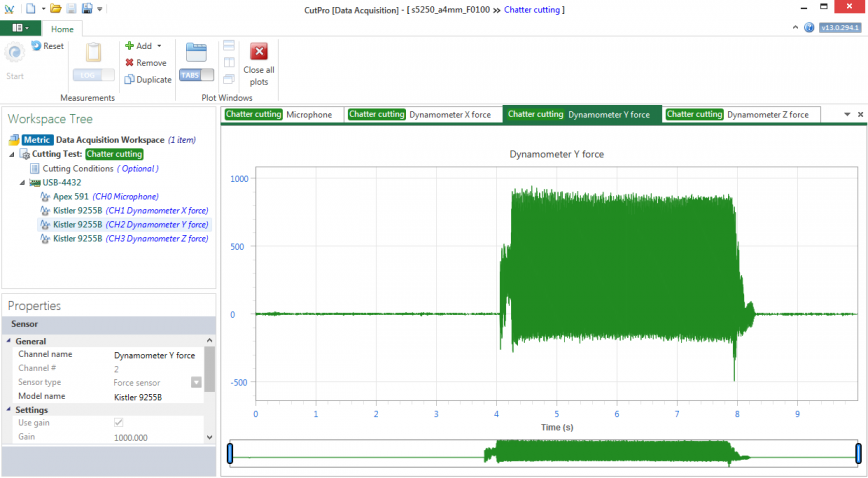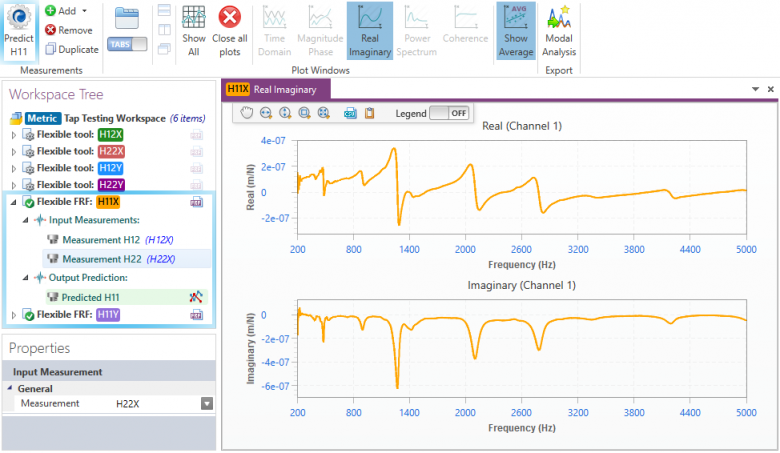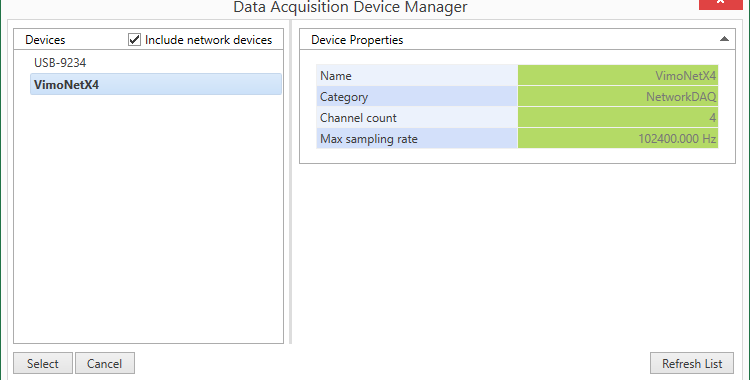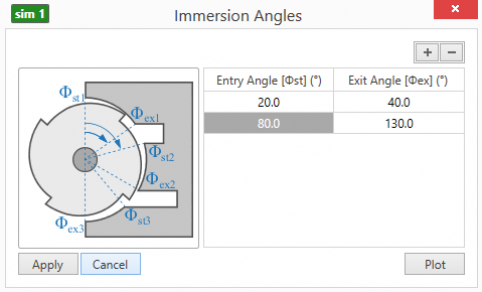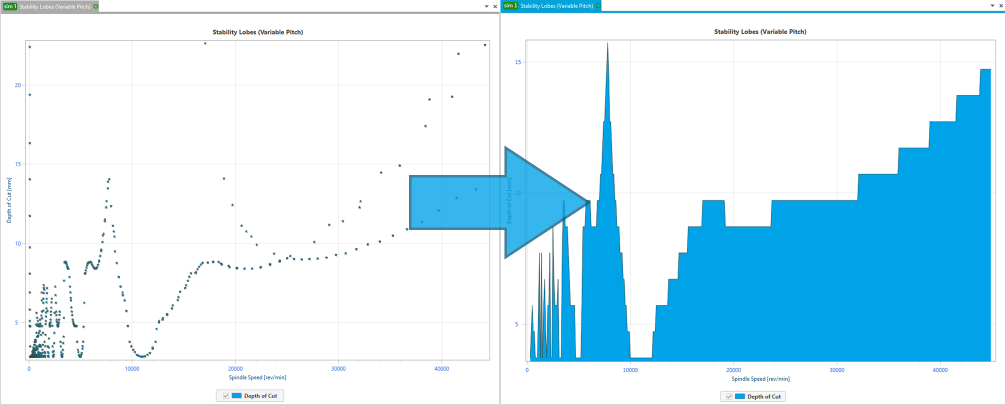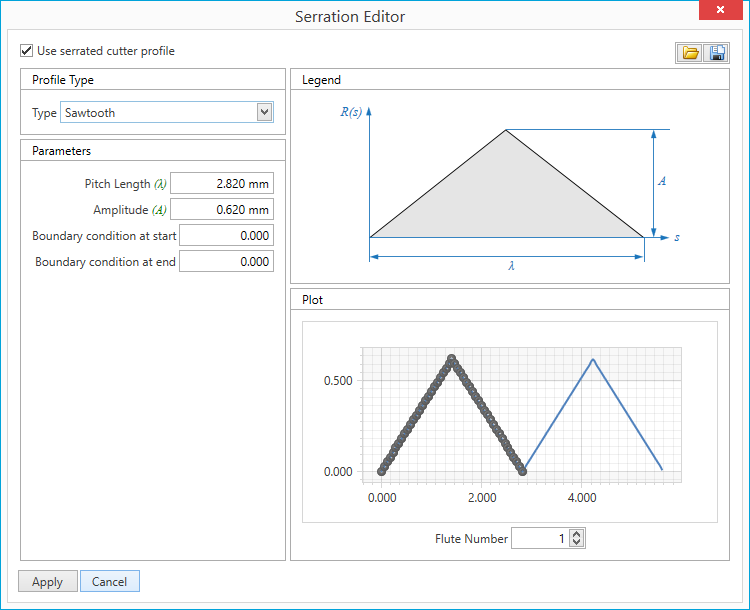CutPro 14 Update
In this blog post we’ll highlight some of the new features and improvements of CutPro 14.0.528.1 in detail.
Current users: If you are not receiving an update notification upon starting CutPro, your support coverage has likely expired. To receive this latest update, please contact our sales team to renew your support coverage.
New Data Acquisition module
The Data Acquisition module (formerly MalDAQ) now has a new user interface that adheres to our design principles in the Machining Simulation, Modal Analysis, and Tap Testing modules.
Old MalDAQ files and its features are still supported under this new module. Enjoy improved workspace organization and navigation thanks to our workspace tree, and easy to use toolbar (ribbon bar) controls with added functionality. The new module also supports a tabbed or MDI/windowed view, like our other modules. Data acquisition is also greatly improved from the old MalDAQ module; adding hardware support for Data Translation and G-Tech VimoNet X4 data acquisition devices, improved connectivity handling, and more.
Simplified flexible tool FRF identification
Flexible tool FRF identification within Tap Testing is now simplified. You can now automatically predict the tool tip FRF directly within Tap Testing without needing to export measurements to Modal Analysis.
When using the Flexible FRF workspace you’ll notice two new “Flexible FRF” items in the workspace tree. With the Flexible FRF item, or one of it’s sub-items selected, the “Predict” button will appear in the ribbon bar. This button generates the predicted FRF for both H11X and H11Y; the flexible tool tip in the X and Y directions, respectively. After generating the predicted tool tip FRF, users can simply save the workspace and import the Tap Testing workspace file into CutPro. This removes the extra step of manually exporting and selecting modes in the Modal Analysis module. This feature is backwards compatible with previously saved Flexible FRF workspaces, and will be automatically converted to the new workspace format upon opening.
G-Tech VimoNet X4 Hardware Support
Our Tap Testing and Data Acquisition modules now supports the VimoNet X4 data acquisition device by G-Tech. The VimoNet X4 features networked connectivity via ethernet, and 4-channels of data acquisition.
Improved device management (Tap Testing/Data Acquisition)
Device selection has been improved with our new device manager in the Tap Testing and Data Acquisition modules. The new manager allows you to easily see device properties and refresh the device list. The improvements also includes an automatic search for VimoNet X4 devices running on your local network, with an option to toggle searching to save time while refreshing devices. Device connection issues are also better handled in this version of CutPro thanks to improved error detection and notifications.
Multiple Immersion Milling Mode
Multiple immersion milling mode has been introduced into the milling simulation module. With this milling mode selected you can simulate milling with existing immersions milled into the metal. In this mode you can define the start and end angles of the immersion gaps, allowing you to define the multiple immersions which will be milled into. To enable this mode, set the ‘Milling Mode’ to multiple immersion, which is found in the workspace tree under ‘Cutting Conditions’ for most milling simulations, then the custom angles may be defined under ‘Cutting Area’.
Ball Endmill Cutting coefficients calculation
Cutting coeffcients for ball endmill tools can now be calculated within CutPro. These calculations enable you to add your custom ball endmill tools into the tool editor, improving tool simulation accuracy.
New variable pitch engine & plotting improvements
The variable pitch engine is now improved by using a new physics model developed by our research team at the University of British Columbia. Simulations using variable pitch can now produce more accurate and reliable results.
Analytical stability plots for variable pitch milling process and optimum variable pitch simulations are displayed as an easier to read mountain plot rather than a scatter plot, as shown in the screenshot above. Variable pitch plots can also now be attached alongside regular pitch plots to easily view differences between the two simulation types.
Receptance Coupling engine and UI improvements
CutPro’s receptance coupling engine and user interface within the tool editor has been improved. Updates to our engine has made results more reliable and error checking has been improved. Receptance coupling interface is now features a wizard-style workflow, and allows for editing of previously created spindlesadob, holders, and tools.
Report Generation
Report generation has been added into Tap Testing and Data Acquisition modules to allow for printing and exporting of tap testing/data acquisition data in a report. The generated report is based on the workspace tree layout and features all the workspace data in a easy to read format. Reports can be printed or exported as a PDF/RTF file.
Mode Shape Improvements
Navigating mode shapes when viewing mode shapes has been simplified and now displays frequency, damping, stiffness, and mass data for each mode. Mode shapes are now easier to navigate with next/previous buttons to switch between optimized modes.
An option to export mode shape matrices has also been added to allow for copy and pasting into external applications. This allows for the mode shape data to be exported alongisde frequency, damping, stifness, and mass for advanced users.
Suggested axial depth for constant forces
The axial depth to achieve constant forces is now calculated and shown when using cylindrical helical end mills to prevent oscillation and achieve improved surface finish. This suggested depth is displayed in the properties panel under cutting conditions.
New serration profile editor
Creating a serration profile is now easier than ever with our new profile editor. Our new editor features a parameterized editor to generate a serration profile automatically. You can choose from trapezoidal, circular, sinusoidal, sawtooth, or custom profile types. A few simple measurements are now all that is needed to make a serration profile.
In previous versions, our editor would require the user to manually enter data point-by-point which can lead to a less accurate serration profile and needless to say is a much more involving task! The point-by-point option still available by using the custom profile type for specialized tools.
New materials added
We have added two new materials: Aluminum 5083 and Steel P20. These materials can be used in any simulation, removing the need to use similar materials which otherwise can introduce errors.
Feed speed cutting condition
Cutting conditions can now also be set by feed speed (f), alongside the existing feedrate (c). Both values will update accordingly when either is changed, giving you to the option to set either condition depending on your preference.
Axial depth for constant forces
In our milling module, you can now see a suggested axial depth to achieve constant cutting forces in milling process simulations. Using this suggested depth as your axial depth of cut will give you a better surface finish. This feature is only available when using a flat end tool type with uniform helix angle, and is shown under the axial depth of cut in the Cutting Condition properties.
New installer
We’ve given our installer a facelift, as well as improved some reliability when upgrading from previous versions. Our new installer also fixes a common issue with our old installer where the user interface would intermittently not display on newer versions of Windows.
Many of these new features and improvements are a direct result from feedback from our users, we would like to thank those users for your contributions! If you have any suggestions, technical issues, or other feedback, feel free to open a ticket at anytime using our Helpdesk!
Interested or want to know more about CutPro? Contact our sales team today to arrange a web demo of our software, and to learn more about our offerings.

